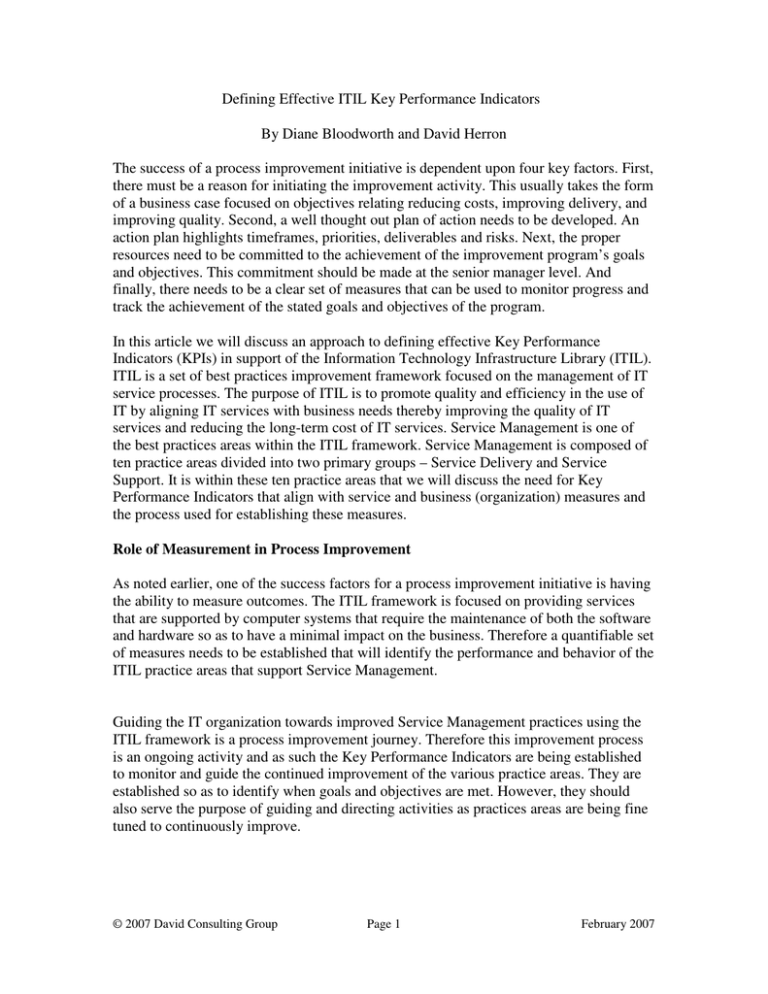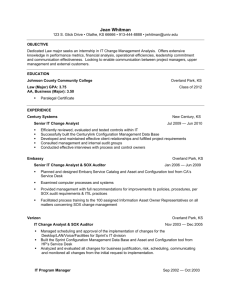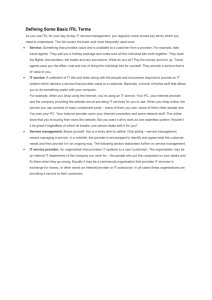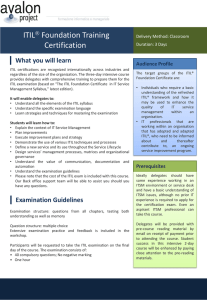Defining Effective ITIL Key Performance Indicators
advertisement

Defining Effective ITIL Key Performance Indicators By Diane Bloodworth and David Herron The success of a process improvement initiative is dependent upon four key factors. First, there must be a reason for initiating the improvement activity. This usually takes the form of a business case focused on objectives relating reducing costs, improving delivery, and improving quality. Second, a well thought out plan of action needs to be developed. An action plan highlights timeframes, priorities, deliverables and risks. Next, the proper resources need to be committed to the achievement of the improvement program’s goals and objectives. This commitment should be made at the senior manager level. And finally, there needs to be a clear set of measures that can be used to monitor progress and track the achievement of the stated goals and objectives of the program. In this article we will discuss an approach to defining effective Key Performance Indicators (KPIs) in support of the Information Technology Infrastructure Library (ITIL). ITIL is a set of best practices improvement framework focused on the management of IT service processes. The purpose of ITIL is to promote quality and efficiency in the use of IT by aligning IT services with business needs thereby improving the quality of IT services and reducing the long-term cost of IT services. Service Management is one of the best practices areas within the ITIL framework. Service Management is composed of ten practice areas divided into two primary groups – Service Delivery and Service Support. It is within these ten practice areas that we will discuss the need for Key Performance Indicators that align with service and business (organization) measures and the process used for establishing these measures. Role of Measurement in Process Improvement As noted earlier, one of the success factors for a process improvement initiative is having the ability to measure outcomes. The ITIL framework is focused on providing services that are supported by computer systems that require the maintenance of both the software and hardware so as to have a minimal impact on the business. Therefore a quantifiable set of measures needs to be established that will identify the performance and behavior of the ITIL practice areas that support Service Management. Guiding the IT organization towards improved Service Management practices using the ITIL framework is a process improvement journey. Therefore this improvement process is an ongoing activity and as such the Key Performance Indicators are being established to monitor and guide the continued improvement of the various practice areas. They are established so as to identify when goals and objectives are met. However, they should also serve the purpose of guiding and directing activities as practices areas are being fine tuned to continuously improve. © 2007 David Consulting Group Page 1 February 2007 Measurement Practices Within the ITIL Framework Identifying the appropriate measures, creating a process for collecting and analyzing the data and effectively using the results to guide and direct continued improvement are essential to establishing a successful measurement process. The following is an outlined approach for implementing ITIL. There are four phases. The essential activities for each phase are identified. Within each phase the measurement activity necessary to create, analyze and report on KPIs has also been identified. The “Initiate” Phase. • Define the scope of the ITIL effort; includes the groups, functions, and processes that are targeted and included in the effort. • Link the ITIL objectives to the organization’s business objectives. • Define the success criteria for the ITIL initiative – ‘How will we know that we have achieved success?’ • KPI Measurement activity – Define priorities Determine quality parameters Establish value criteria Business case or ROI for implementing ITIL The “Assess” Phase. • Document a description of the Current State for the functions or processes that are included in the scope of the ITIL effort. • Identify the Desired Future State by comparing the Current State to the Best Practices in ITIL. • Report strengths as well as gaps or weaknesses that should be addressed. • KPI Measurement activity – Baseline performance Evaluate performance Identify supporting data Identify data gaps The “Plan” Phase. • Plan improvements for the Gaps from the Assess Phase based on the organization’s timeline and available resources. • KPI Measurement activity – Develop measurements Define metrics Develop Measurement collection process The “Implement” Phase. • Designed, developed, and rolled out the future state solution. • Determine if the success criteria has been achieved. • KPI Measurement activity – Evaluate information Id process impacts Define improvements © 2007 David Consulting Group Page 2 February 2007 Creating Key Performance Indicators To define meaningful KPI measures that align with the goals of the organization, the following questions need to be asked: • • • • What are the business / organization measures? How do these translate into IT service measures? How does a process support the IT service measures? How will I collect and analyze the measure? Noted below we have included an example of KPI measures and the corresponding definitions and goals. Process Goal (Critical Success Factor) Measure Definition Measurement Architecture Service Level Management Improve ability to track and meet service levels agreed to with client Percentage increase or decrease in meeting service level targets Tracked through Incident Management and reported monthly Change Management Reduce incidents caused by unauthorized changes Percentage reduction in the number of incidents resulting from unauthorized changes Tracked through Incident Management and Change Management and reported monthly Effectively Using Key Performance Indicators Once the measures are defined and linked to the various business goals the focus of the measurement activity is on the measurement process itself. How the data is going to be collected, analyzed and reported needs to defined. The measurement program will identify the sources of data and who is responsible for the measurement activity. The overall intent is to use the measures to evaluate and improve the processes. The KPIs should provide insight into: 1. Quality – How well is the process working? Are we improving toward goals that were established for this process? 2. Efficiency – Is the throughput of the process sufficient? 3. Compliance – Is the process being followed? 4. Value – Are we doing what we are supposed to be doing? An overview of the measurement activity is noted below. © 2007 David Consulting Group Page 3 February 2007 Establish Metrics Goals Develop Measures and Processes Define Priorities Determine Quality Parameters Establish value criteria Baseline Performance Identify KPIs Develop measurements Define metrics Identify supporting data Benchmark model Identify data gaps Evaluate performance Develop measurement collection processes Evaluate performance Evaluate alignment Communicate achievement Improve model Improvement Initiatives Scorecard Evaluate information Id process impacts Clarify criteria Define relationship improvements In Summary Defining and establishing effective ITIL Key Performance Indicators requires a rigorous measurement process. As the ITIL framework is being planned and implemented KPIs are being defined in parallel. The measures must support the needs of the business and provide insight as to how the various improvement processes within ITIL are performing. Along with the ITIL framework, a well defined measurement activity must be established. © 2007 David Consulting Group Page 4 February 2007







